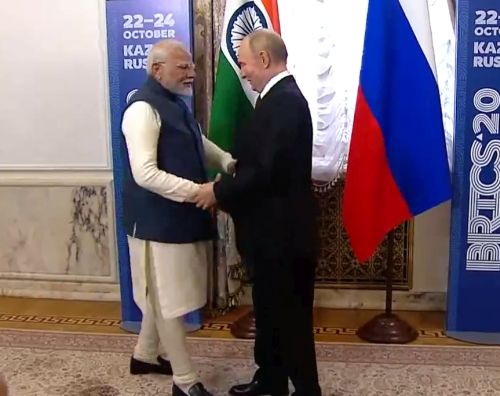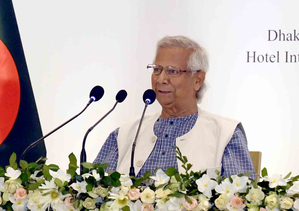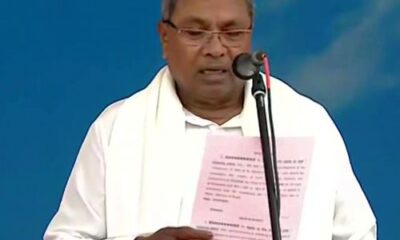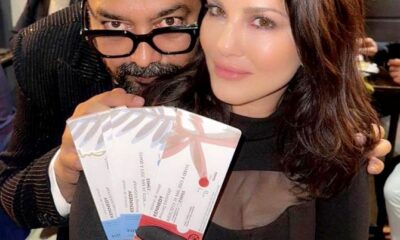International
ITER fusion energy project in France completes complex magnet system
Cadarache (France), July 1 (IANS) After two decades of design, production, fabrication and assembly on three continents, the historic, multinational ITER fusion energy project, to which India is one of the partner nations, on Monday celebrated the completion and delivery of its massive toroidal field coils from Japan and Europe.
Masahito Moriyama, Japan’s Minister of Science and Technology, and Gilberto Pichetto Fratin, Italy’s Minister of Environment and Energy Security, attended the ceremony with officials from other ITER members.
Nineteen gigantic toroidal field coils have been delivered to southern France. They will be key components in ITER, the experimental fusion mega-project that will use magnetic confinement to imitate the process that powers the sun and stars and gives earth light and warmth.
Fusion research is aimed at developing a safe, abundant, and environmentally-responsible energy source.
The ITER is a collaboration of more than 30 partner countries: the European Union, China, Japan, Korea, Russia and the US, besides India. Most of ITER’s funding is in the form of contributed components. This arrangement drives companies like Mitsubishi Heavy Industries, ASG Superconductors, Toshiba Energy Systems, SIMIC, CNIM, and many more to expand their expertise in the cutting-edge technologies needed for fusion.
The ITER is the first-of-a-kind global collaboration coming up in Saint-Paul-les-Durance, some 35 km north of Aix-en-Provence in southern France.
The D-shaped toroidal field coils will be placed around the ITER vacuum vessel, a donut-shaped chamber called a tokamak. Inside the vessel, light atomic nuclei will be fused together to form heavier ones, releasing enormous energy from the fusion reaction.
The fuel for this fusion reaction is two forms of hydrogen, deuterium and tritium (DT). This fuel will be injected as a gas into the tokamak. By running an electrical current through the gas, it becomes an ionized plasma — the fourth state of matter, a cloud of nuclei and electrons.
The plasma will be heated to 150 million degrees, 10 times hotter than the core of the sun. At this temperature, the velocity of the light atomic nuclei is high enough for them to collide and fuse. To shape, confine, and control this extremely hot plasma, the ITER tokamak must generate an invisible magnetic cage, precisely conformed to the shape of the metal vacuum vessel.
The ITER uses niobium-tin and niobium-titanium as the material for its giant coils. When energized with electricity, the coils become electromagnets. When cooled with liquid helium to minus 269 degrees Celsius (4 kelvin), they become superconducting.
To create the precise magnetic fields required, ITER employs three different arrays of magnets. The 18 D-shaped toroidal field magnets confine the plasma inside the vessel. The poloidal field magnets, a stacked set of six rings that circle the tokamak horizontally, control the position and shape of the plasma.
At the centre of the tokamak, the cylindrical central solenoid uses a pulse of energy to generate a powerful current in the plasma. At 15 million amperes, ITER’s plasma current will be far more powerful than anything possible in current or previous tokamaks.
Ten coils were manufactured in Europe, under the auspices of ITER’s European Domestic Agency, Fusion for Energy (F4E). Eight coils plus one spare were made in Japan, managed by ITER Japan, part of the National Institutes for Quantum Science and Technology (QST).
Each completed coil is huge: 17 metres tall and nine metres across, and weighing about 360 tons.
The toroidal field coils will operate together, in effect, as a single magnet: the most powerful magnet ever made.
They will generate a total magnetic energy of 41 gigajoules. ITER’s magnetic field will be about 250,000 times stronger than that of the earth.
“The completion and delivery of the 19 ITER toroidal field coils is a monumental achievement,” said Pietro Barabaschi, ITER Director-General. “We congratulate the member governments, the ITER domestic agencies, the companies involved, and the many individuals who dedicated countless hours to this remarkable endeavour.”
The plant at ITER will produce about 500 megawatts of thermal power. If operated continuously and connected to the electric grid, that would translate to about 200 megawatts of electric power, enough for about 200,000 homes.
A commercial fusion plant will be designed with a slightly larger plasma chamber, for 10-15 times more electrical power. A 2,000 megawatt fusion power plant, for example, would supply electricity for 2 million homes.
India contributes through the Gujarat-based Institute for Plasma Research by manufacturing major components of the plasma chamber where the fusion reactions are going to take place for the first time in 2025.
Fusion power plants are carbon-free; they release no CO2.
–IANS
vg/bg
International
Lee Hsien Yang seeks refuge in United Kingdom

Lee Hsien Yang, the youngest son of Singapore’s founding father, the late Lee Kuan Yew, announced on Tuesday that he is now a political refugee in the United Kingdom after seeking asylum from the British government “as a last resort.”
“I remain a Singapore citizen and hope that someday it will be safe to return home,” Lee stated in a Facebook post, as reported by Channel News Asia (CNA).
Citing what he described as the Singapore government’s “attacks” against him, Lee, who is the younger brother of former Prime Minister Lee Hsien Loong, revealed that he sought asylum protection in 2022.
Lee Hsien Yang and his late sister, Lee Wei Ling, who passed away earlier this month, have been in conflict with their brother Lee Hsien Loong over the fate of their father’s home following his death in 2015, resulting in a public dispute that has estranged the siblings.
In an interview with the UK-based newspaper The Guardian, Lee alleged that a “campaign of persecution” compelled him to seek asylum in Britain.
In response to his claims, the Singapore government stated that there is “no basis” for his allegations of “a campaign of persecution” or other assertions regarding political repression in the country.
“Singapore’s judiciary is impartial and makes decisions independently. This is why Singaporeans have a high level of trust in the judiciary,” a government spokesperson remarked.
The spokesperson added that there are no legal restrictions preventing Lee and his wife, lawyer Lee Suet Fern, from returning to Singapore. “They are and have always been free to return to Singapore,” the spokesperson said.
Lee and his wife have been outside of Singapore since 2022, having opted not to attend a scheduled police interview regarding potential offenses related to providing false evidence in judicial proceedings concerning their father’s will and the family home.
Lee and his late sister, who had been living at the property, alleged they felt threatened while trying to fulfill their father’s wish to demolish the house. They also accused their elder brother, former Prime Minister Lee Hsien Loong, of abusing his governmental influence to advance his personal agenda.
International
Indo-Russian ties are stronger than ever before at BRICS

Kazan, Russia: Prime Minister Narendra Modi held a bilateral meeting with Russian President Vladimir Putin on the sidelines of the 16th BRICS Summit.
During the meeting, President Putin remarked, “I recall our meeting in July, where we had productive discussions on various issues. We’ve also spoken over the phone several times. I am very grateful you accepted the invitation to come to Kazan. Today, we will attend the BRICS Summit’s opening ceremony, followed by dinner.”
PM Modi responded by expressing his appreciation, saying, “I sincerely thank you for your friendship, warm welcome, and hospitality. It’s a great pleasure to visit such a beautiful city as Kazan for the BRICS Summit. India shares deep historical ties with this city, and the opening of our new embassy here will further strengthen these connections.”
International
Laos seeks to enhance nutrition amid climate change concerns

Vientiane (Laos), Aug 22 (IANS) Representatives from the Lao government and development partners have attended a conference here titled “Climate Change and Nutrition in Laos: Intersections and Interventions” to discuss the impact of climate change on nutrition in the Southeast Asia country and potential solutions.
Speaking at the conference, deputy director general of the Department of Hygiene and Health Promotion under the Lao Ministry of Health Viengkhan Phixay, said, “We gather to address a critical and interwoven issue: the impact of climate change on nutrition and how we can work together to tackle these challenges,” Xinhua news agency reported.
The Lao government is actively engaged in this endeavor, with numerous policies and initiatives aimed at addressing both climate change and nutrition, Lao National Television reported on Thursday.
“By leveraging the Scaling Up Nutrition network in Laos, which is led by the government, and supported by civil society, donors, and the United Nations, we have a robust platform to tackle the negative impacts of climate change while improving nutrition and overall health for everyone in Laos,” Viengkham said at the conference held on Monday.
The conference featured a series of presentations that not only detailed evidence-based research but also introduced innovative tools for measuring and enhancing nutrition under the impact of climate change.
The conference stressed the critical need for integrated approaches to tackle the intertwined challenges of climate change and nutrition, and setting the stage for impactful future collaborations.
–IANS
int/psd
International
One killed, seven injured in shootout in Iraq

Baghdad, Aug 22 (IANS) A civilian was killed while seven others were injured on Thursday in a tribal shootout in Iraq’s holy Shiite province of Najaf, according to a local security source.
The shootout erupted in the early hours between armed men from the local tribe in the al-Zarga area in northern Najaf, some 160 km south of Baghdad, a local police officer told Xinhua on condition of anonymity.
The clash resulted in the killing of an Iraqi civilian and the injury of seven others, including three Iranian Shiite pilgrims, the source added.
A joint force from the Interior Ministry’s emergency response division and Najaf provincial police arrested 53 gunmen from both sides of the shootout and seized weapons and ammunition, the Interior Ministry said in a statement.
It added that search operations are ongoing to locate additional gunmen and weapons, with more details to be released later.
The incident took place as numerous pilgrims traveled to the city of Karbala to observe Arbaeen, which marks the end of a 40-day mourning period for the killing of Imam Hussein, the grandson of Prophet Muhammad, in the Battle of Karbala in 680 A.D.
Typically, these pilgrims also visit Najaf as part of their journey to Karbala.
–IANS
int/jk/arm
International
Bangladesh seeks $1 billion budget support from World Bank

Dhaka, Aug 22 (IANS) Bangladesh’s interim government has sought $1 billion from the World Bank as budgetary support.
The call came from the country’s Power, Energy and Mineral Resources Adviser Muhammad Fouzul Kabir Khan’s meeting with Abdoulaye Seck, the World Bank’s Country Director for Bangladesh and Bhutan, in Dhaka on Wednesday.
He made the plea as the ministry owes more than 2 billion dollars to suppliers in import costs of power and energy, Xinhua news agency reported.
Khan mentioned that the interim government, which was formed with many pressing mandates, is due to settle a $2 billion debt left by the previous government in the power sector.
He said they have already suspended activities under the much-criticized Quick Enhancement of Electricity and Energy Supply Act 2010 and abolished the government’s power to set energy prices without any public hearing.
On August 5, the former Prime Minister of Bangladesh, Sheikh Hasina, was ousted from her country and power, ending her rule since January 2009.
This event was seen as a massive escalation, with what initially started as student’s protests and resulted in a major crisis in Bangladesh.
Earlier on August 8, Nobel laureate Muhammad Yunus took oath as the head of Bangladesh’s interim government.
–IANS
int/jk/as
-
Video2 years ago
PM Modi Attacks Congress in Karnataka with “Kerala Story”
-
Politics2 years ago
Siddaramaiah & DK Shivakumar sworn in as Chief Minister & Deputy CM respectively
-
Cricket2 years ago
CSK players rejoice 5th IPL title with their families (Pics)
-
Entertainment2 years ago
Karan Deol weds his longtime Girlfriend Drisha Acharya (Pics)
-
Sports7 years ago
History Of Official FIFA WORLD CUP Match balls
-
Entertainment2 years ago
Urvashi Rautela dazzles on Cannes 2023 red carpet (Pics)
-
India2 years ago
Ashwini Vaishnaw: Railway Board recommends CBI probe in the Odisha railway disaster
-
Entertainment2 years ago
Sunny Leone gets ready for Kennedy premiere in Cannes (Pics)






























